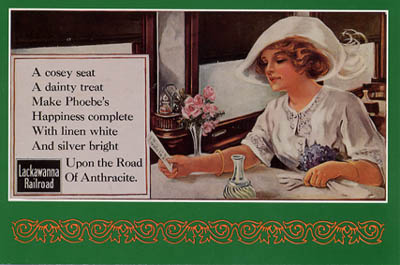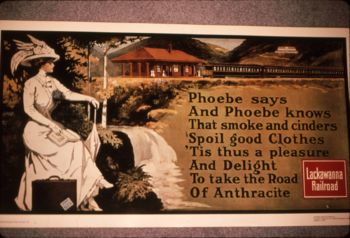Phoebe Snow
Phoebe Snow was a fictional character created to promote the Delaware, Lackawanna and Western Railroad, and, in later years, the name of a pair of passenger trains.
Rail travel around the year 1900 was a messy business. After a long trip on a coal-powered train, travelers would frequently emerge covered in black soot. The exception to that rule were locomotives powered by anthracite, a clean-burning form of coal. The Lackawanna owned vast anthracite mines in Pennsylvania, and could legitimately claim that their passengers' clothes would still look clean after a long trip.
To promote this fact, their advertising department created Phoebe Snow, a young New York socialite, and a frequent passenger of the Lackawanna. For reasons never explained, Miss Snow often traveled to Buffalo, New York, always wearing a white dress.
The first ad featured the image of Phoebe and a short poem:
- Says Phoebe Snow
- about to go
- upon a trip to Buffalo
- "My gown stays white
- from morn till night
- Upon the Road of Anthracite"
The campaign became a popular one, and soon Phoebe began to enjoy all the benefits offered by DL&W: Gourmet food, courteous attendants, an observation deck, even on-board electric lights:
- Now Phoebe may
- by night or day
- enjoy her book upon the way
- Electric light
- dispels the night
- Upon the Road of Anthracite
Phoebe soon became one of the United States' most recognized advertising mascots. During World War I, anthracite was needed for the war effort, and its use on railroads was prohibited, thus ending her career, but her legend remained alive among railroad fans.
Contents
Lackawanna Passenger Train
On November 15, 1949, the Lackawanna launched a streamlined passenger train named after its mascot, The Phoebe Snow. It assumed the train numbers 3 and 6 of the railroad's previous premier train, The Lackawanna Limited, and ran on a daylight schedule between Hoboken, New Jersey, and Buffalo, New York. Westward, the sleeper and some coaches would continue onto Chicago over the Nickel Plate Road (New York, Chicago and St. Louis Railroad) and, on return, would be attached in Buffalo to train No. 10, the New York Mail. Motive power was initially provided by an A-B-A set of passenger-equipped EMD F3 diesels, later supplanted by a pair of EMD E8A diesel-electric locomotives.
Erie Lackawanna Passenger Train
Under the Erie Lackawanna, the train ran from 1963 to 1966 on a more southerly Hoboken-Chicago routing, skipping Buffalo by heading west from Corning, New York over the main line of the former Erie Railroad. The train remained mostly unchanged from its Lackawanna version.
Disposition of cars
Both of the tavern-lounge cars from the Phoebe Snow wound up in the possession of Metro-North where they serve in the Metro-North business train after being used as parlor cars by the Long Island Rail Road on trains to Montauk, Greenpoint, and the Hamptons. The coaches were also split up with most being sold to the New York MTA where they were used as commuter cars. At least one coach ended up in the hands of Conrail where it was used on the "Valpo Local" out of Chicago. One of two smoothside streamlined diners built for the Phoebe Snow is owned by the Erie Lackawanna Dining Car Preservation Society, a non-profit historical group, and is currently under restoration.
Amtrak era
In 1979, Amtrak ran an inspection train over Phoebe's route between Hoboken and Scranton as part of an expansion plan, however Amtrak had to discontinue numerous routes due to budget cuts at the hands of the Carter administration. In 1991 Amtrak consolidated its New York City operations into Penn Station; five years later the Kearny Connection opened, allowing trains on the Lackawanna to access Penn Station.


